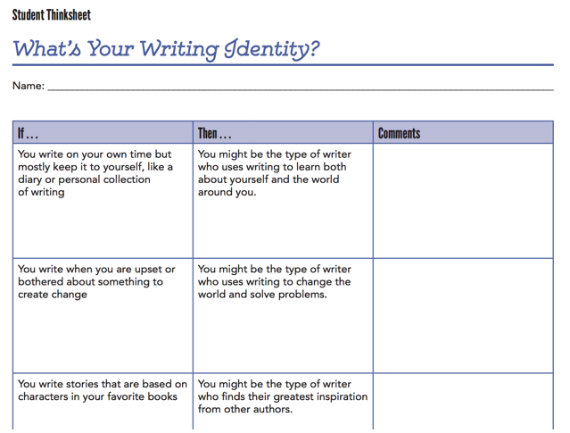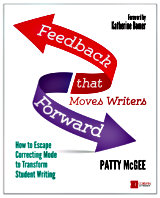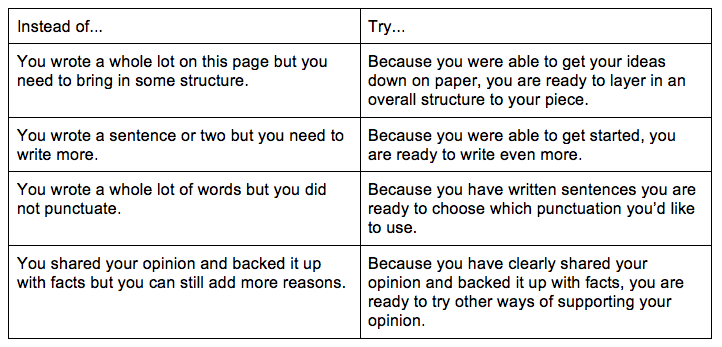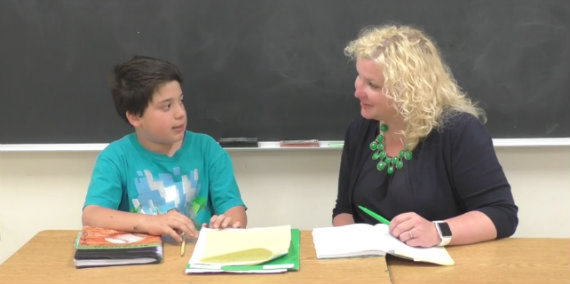Teachers! Step Away From That Red Pen!
 By Patty McGee
By Patty McGee
There’s a better way of giving feedback to writers, and it does not include a red pen.
Instead, it involves you as the writing mentor, helping activate student writers to learn powerful moves that create quality writing with originality, voice, and style.

What’s more, correcting student writing takes hours and hours with only a little impact in the long run; commonly, corrections made on one piece are not considered by the writer in future writing efforts.
It’s time to put down the pen and respect the writer.
When we were young authors ourselves, perhaps the red pen approach felt a bit harsh to our own writing persona, and now we wonder what affect it has on the writers in our care.
At some point we need to seriously question any practice that makes us feel less than our authentic teacher selves and shift to practices that nurture us as well as our students. I have to admit that I was the champion of the red pen for quite a while – until I discovered the countless ways of giving feedback that is appreciative, nurtures the writer, and in turn, enhances the quality of the writing.
Ditching the red pen
Pointer #1: Think of the writer first.
If we head exclusively to the writing products when giving feedback, we are overlooking an essential ingredient of strong writing: the writers themselves. Writing is a vulnerable act where students choose bits of themselves – their ideas, beliefs, thoughts, skills, struggles, voice – and lay them out on the page for others to see, critique, praise, or even overlook.
As they move through adolescence, middle grades students are increasingly aware of the courage it takes to write and are often fearful to try. With this at the forefront of our minds when giving feedback, our actions and words will fall in step. Our responses are more likely to be grounded in writer-centered, appreciative feedback. To discover more about your writers you may want to also try out this tool:

Pointer #2: Name what is working and next steps.
When I work with writers in the middle grades, I am often bowled over by the richness of voice, the development of humor, the cleverness of dialogue, etc. because students at this age are so in the midst of this repartee. It is important that writers recognize these strong qualities within their writing.
That said, we also want to share ways students can enhance their writing even more. It is a tricky middle ground because our writers are keenly aware of what they need to improve and often feel the sting of corrections, even if we frame our feedback with the most careful, kind wording. It is as if they hardly hear their strengths because they are anticipating what seems to be the inevitable: what is wrong.
One way to help the writer see that our feedback is building upon strengths is eliminating the word but from our vocabulary. Replace it with words that create forward momentum (not put on the brakes). Words like because or you are ready…
Here’s an example: A common feedback response might be, “I love the way you wrote in full sentences but you need to vary your sentence structure.” Notice how anything that came before “but” sounds like a liability. The same feedback without the word “but” could be, “Because you wrote full sentences, you are ready to vary your sentence structure. Let me show you a few ways.” Here are some other examples of how to rephrase feedback and leave out the “but.”
This switch makes a world of difference to a writer. It makes certain that what s/he has already written is perceived as an important step in the journey of writerly growth.
Pointer #3: Support choice-making.
One of the biggest challenges I hear from writing teachers is the disengagement and ambivalence of many student writers. On the flip side, the teachers also feel challenged by the most engaged writers who want to do more than complete a task – they want to create, mold, and craft their writing.
Surprisingly, there is an approach that supports both sides of the coin. Choice. To be clear: choice does not mean “off you go, it’s a free-for-all, write with abandon.” In fact, most writers want to know what is expected from the product.
Choice means that there are options: should I use a semicolon or a period? How might I craft this sentence? In what ways can I structure this piece? When giving feedback I often first ask, “What are you trying to share? What are you really trying to say?” And then after I listen for a bit I say, “I have some options for you.”
When writers envision their audience or they have a larger purpose for putting their voice out into the world, they take charge of their writing, and what they say becomes that much more clever, emotional, and original.
Take a look at this video as an example of supporting Alejandro’s writerly choices:
Click on the image to link to the video.
Perhaps you are on-board for offering choices but you’re not sure where to start. Take a peek at these tools to support choice in structure, elaboration, and even grammar. Among the resources, you’ll find Feedback Tracker, Writer’s Notebook Feedback and Grades, Grading Framework, What’s Your Writing Identity?, Language That Fosters a Supportive Tone, Tips for Goal-Centered Conferring & Structuring Feedback Time, The Iceberg Illusion, and many more.
Small shifts – Big impact
These three pointers are tiny shifts for many teachers, yet have a whopping impact on the writer and writing. Imagine how writers will grow under the influence of appreciative feedback. Imagine the joy you will have as a teacher. This is the feedback that moves writers forward.







































Love your list of “instead of,” “try…” Red ink is like bleeding all over the paper.
There is 120 years of research showing grading essays is not reliable or valid and for the instructor to have absolute power to subjectively and arbitrarily evaluate students terrorizes students and stifles discussion.
No red pen in the formative years? I get it but disagree because as a college professor for Introduction to College Writing, the students want their work to be right but have no idea how to make it so because no one as ‘red-penned’ them along their writing journey…..
We can certainly show how to write well without the red pen approach. There are so many alternatives!
I agree with you. There is a difference between revision and editing; editing does not always just come magically–if grammar and mechanics are not addressed at some point, the errors will continue.
Dr. Smith, I think the best way to learn to write is to rewrite, and too often students are simply expected to read the red-inked criticisms and use them to improve their next paper rather than the one they just wrote. So, not matter what the color ink, the teacher’s suggestions go to waste.
oops, “no matter,” not “not matter.”
I agree with corrections, that is, re-writing the whole essay. A tedious process but it helps. Can’t do this all the time though >. <
I love the positive approach and will try to see if it will create a better impact on young writers. As far as what it says about red pen, we ditched that years ago. We do use scaffolds to mark writing so pupils can self assess and set next steps.
However, most of the time it is still not giving the desired results.